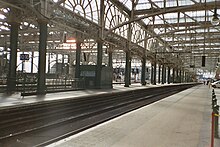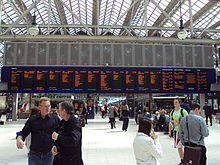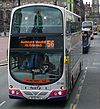
The North Clyde Line is a suburban railway in West Central Scotland. The route is operated by ScotRail Trains. As a result of the incorporation of the Airdrie–Bathgate rail link and the Edinburgh–Bathgate line, this route has become the fourth rail link between Glasgow and Edinburgh.

Dalmuir railway station is a railway station serving the Dalmuir area of Clydebank, West Dunbartonshire, Scotland. It is a large, five-platform interchange between the Argyle Line, North Clyde Line and West Highland Line.

Yoker railway station serves the district of Yoker, Scotland.
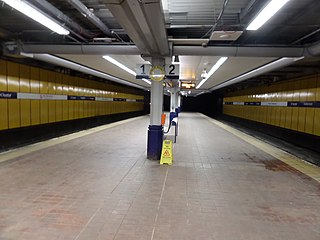
Anderston railway station serves Glasgow's financial district of Anderston and, across the M8 motorway, the housing schemes of both Anderston West and the Blythswood Court estate of the Anderston Centre. It is also close to both the Hilton and Marriott hotels. It is a staffed station with an island platform and most of it is underground.

Argyle Street railway station is a station in the City Centre of Glasgow, Scotland, on the Argyle Line, which connects the North Clyde lines at Partick with Rutherglen in the south-east of the city. The station is located below the thoroughfare whose name it bears. It has a narrow and often crowded island platform. It serves the Argyle Street shopping precinct as well as the St Enoch Centre. Along with Dalmarnock and Anderston, no services call at this station on a Sunday before 10am or after 6pm.

Anniesland railway station is a railway station that serves the Anniesland suburb of Glasgow, Scotland.

Westerton railway station is a railway station that serves the Westerton district in the town of Bearsden, Scotland. The station is managed and served by ScotRail as part of the Strathclyde Partnership for Transport network. It is located on the Argyle and North Clyde lines, between Drumchapel to the west, Bearsden to the north, and Anniesland and Maryhill to the south-east. It is 6 miles 10 chains (9.9 km) west of Glasgow Queen Street, measured via Maryhill.

Cambuslang railway station is a railway station which serves the town of Cambuslang, South Lanarkshire, Scotland. The station is 5 miles (8 km) south east of Glasgow Central, and is regularly served by trains on the Argyle Line to and from Glasgow Central. Passenger services are provided by ScotRail Trains on behalf of Strathclyde Partnership for Transport (SPT).

Hamilton Central railway station serves Hamilton, South Lanarkshire in Scotland, lying on the Argyle Line. It is situated in the town centre, adjacent to the Hamilton bus station, as well as the Regent Shopping Centre, Hamilton's main shopping location. In March 2007, SPT announced a redevelopment of the bus and railway stations into a combined interchange, which was completed in winter 2012.

Hamilton West railway station serves the Hamilton West area of Hamilton, South Lanarkshire, in Scotland, lying on the Argyle Line.
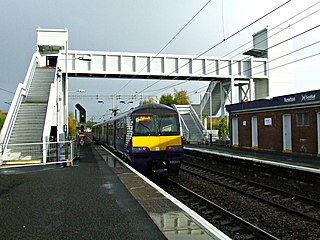
Newton railway station is a railway station located between the neighbourhoods of Drumsagard, Halfway, Newton and Westburn in the town of Cambuslang, Scotland. The station is managed by ScotRail on the Argyle and Cathcart Circle Lines.

Airbles railway station serves the Airbles area of Motherwell, North Lanarkshire in Scotland. It is located around 1⁄2 mile (1 km) away from Fir Park stadium, home of Motherwell F.C.

Partick station is an interchange station in the Partick area of Glasgow, Scotland. Along with an adjacent bus station, it forms one of the main transport hubs in Glasgow. The station is served by Glasgow Subway and National Rail services and was one of the first to receive bilingual English and Gaelic signs, because there is a significant Gaelic-speaking population in the Partick area.

Hyndland railway station serves Hyndland in Glasgow, Scotland. The station is 3+1⁄4 miles (5.2 km) west of Glasgow Central and 2+3⁄4 miles (4.4 km) west of Glasgow Queen Street on the Argyle and North Clyde Lines. It is managed by ScotRail.

Scotstounhill railway station serves Scotstounhill in Glasgow, Scotland. The station lies on the Argyle and North Clyde lines, serving the districts of Scotstoun and Knightswood, with trains to and from Glasgow Central or Queen Street stations and on into the east end.

Carluke railway station is a railway station on the West Coast Main Line (WCML) that serves the town of Carluke, South Lanarkshire, Scotland. The station is managed by ScotRail and is predominantly served by Argyle Line commuter trains running between Lanark and Glasgow Central. The station lies at the western edge of the town, and enjoys panoramic views of the Clyde Valley and beyond to the hills of Lanarkshire and Ayrshire.

Cardross railway station is a railway station serving the village of Cardross, Scotland. The station is 19 miles 50 chains (31.6 km) from Glasgow Queen Street, measured via Singer and Maryhill. It is on the North Clyde Line between Dalreoch and Craigendoran, positioned on the banks of the north side of the River Clyde. The station is managed by ScotRail, who operate all services.

Charing Cross (Glasgow) is a railway station close to the centre of Glasgow, Scotland, serving the district of the same name. It is managed by ScotRail and is served by trains on the North Clyde Line.

Greenfaulds railway station serves the Greenfaulds area of Cumbernauld, North Lanarkshire, Scotland. It is also within walking distance of the Lenziemill industrial estate, the Luggie Water and the Blairlinn industrial estate. The station is managed by ScotRail and is located 13+1⁄4 miles (21.3 km) north east of Glasgow Queen Street on the Cumbernauld Line and is 11 miles (18 km) north of Motherwell railway station on the Motherwell to Cumbernauld Line.

Cumbernauld railway station serves the town of Cumbernauld, Scotland. The station is managed by ScotRail and is located on the Cumbernauld Line, 14 miles (23 km) north east of Glasgow Queen Street station and the Motherwell to Cumbernauld Line, 11+3⁄4 miles (18.9 km) north of Motherwell. Trains serving the station are operated by ScotRail.








